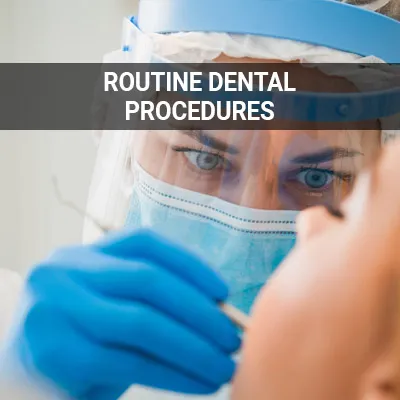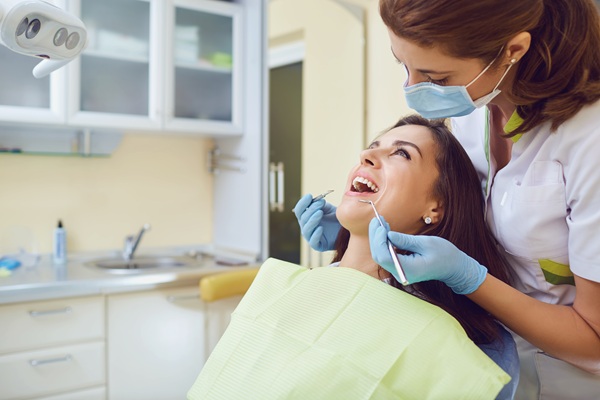Oral Cancer Screening Modesto, CA
Oral cancer screenings can identify the signs of disease before it has spread. This may be beneficial to those in high-risk groups. Regular oral cancer screenings can give patients the advantage of treating cancer in the early stages when there is a higher chance for remission.
Oral cancer screenings are available at Great Smiles Dental in Modesto and the surrounding area. Early detection may make cancer treatment more effective. Call us at (209) 222-3636 to schedule an appointment today.
Why Have Regular Oral Cancer Screenings?
Regular oral cancer screenings can be as important as regular dental checkups. Fortunately, patients can ask to get both procedures done at the same time. As per the National Cancer Institute, oral cancer symptoms tend not to appear until the disease has spread. Early detection may make oral cancer easier to treat when the chances for remission are higher.
According to WebMD, everyone should have a dental checkup at least once a year. However, experts have yet to reach a consensus on how often patients should go in for an oral cancer screening. A dentist may be able to conduct a comprehensive exam to determine how frequently a patient should have screenings.
“Early detection may make oral cancer easier to treat when the chances for remission are higher.”
What to Expect During the Test
Oral cancer screenings are typically integrated into a routine dental check-up, so a patient may not even notice when a dentist is performing a screening exam. During the typical oral cancer test, the dentist will examine the entire oral cavity, including the lining of the cheeks, the gums, the tongue, the hard palate, the back of the throat, and the lips. The patient may feel the dentist moving their gloved fingers along these structures to palpate the tissue, but the exam should not cause any pain or discomfort. The dentist will also look globally at the structures of the face and neck, checking for symmetry.
To do a more in-depth screening, some dentists may use a special blue light to assess particular areas. If a spot of interest is detected during oral cancer screening, the dentist may perform a biopsy or refer the patient to another provider for this procedure.
“The patient may feel the dentist moving his or her gloved fingers along these structures to palpate the tissue, but the exam should not cause any pain or discomfort.”
Limitations of Oral Cancer Screenings
Although regular oral cancer screenings are integral to maintaining good health, Mayo Clinic points out that it may be difficult to detect abnormal cells through a simple visual exam. Thus, there is always a possibility that a small sign of cancer or precancerous lesion could go undetected.
A group of unusual cells does not always mean that the patient has cancer. Rather, the patient will have to undergo a biopsy to get a definitive answer. If it is cancerous, then early detection will afford the patient more treatment options.
While the evidence does not yet link screenings with reduced oral cancer deaths, regular screenings may help identify cancers early at a time when remission is more likely.
“While the evidence does not yet link screenings with reduced oral cancer deaths, regular screenings may help identify cancers early at a time when remission is more likely.”
Check out what others are saying about our dental services on Yelp: Oral Cancer Screening in Modesto, CA
When Would a Dentist Advise a Test?
An oral cancer screening is simple enough to be performed during every check-up, and the American Dental Association recommends a thorough evaluation of the oral cavity during a regular exam.
For most patients, a dentist will advise a routine dental visit every six months, so some form of oral cancer test may be administered twice yearly. Some dentists may conduct a more formalized oral screening at a different interval. For patients who have a history of oral cancer or who have significant oral cancer risk factors, a dentist may conduct more frequent oral screenings.
“For most patients, a dentist will advise a routine dental visit every six months, so some form of cancer screening may be administered twice yearly.”
Questions Answered on This Page
Q. How frequently should I get an oral cancer screening?
Q. What are the limits of oral cancer screenings?
Q. Are there any additional tests after oral cancer screenings?
Q. What is an oral cancer screening like?
Q. How often should a patient get an oral cancer screening?
People Also Ask
Q. What should be included in an at home oral health routine?
Q. Who is at risk of gum recession?
Additional Tests After Oral Cancer Screenings
Depending on the patient's situation, the dentist may perform special tests in addition to the basic screening. More in-depth oral cancer screenings can involve the patient rinsing their mouth with blue dye to make any unusual cells more visible. Additionally, the dentist may choose to shine a light in the patient's mouth during the exam. This light will "highlight" abnormal tissue by making it appear white.
If any of these tests find signs of oral cancer or any possibly cancerous lesions, then the patient should undergo a biopsy. This procedure consists of removing a sample of cells for laboratory testing. The patient may also need to make a follow-up appointment to see if the abnormal area has grown or changed since detection.
“Depending on the patient’s situation, the dentist may perform special tests in addition to the basic screening.”
Frequently Asked Questions
Q. How common is oral cancer?
A. According to the American Dental Association, more than 50,000 people in the U.S. are diagnosed with oral cancer every year. While this is intimidating, you can lower your risk of developing oral cancer by avoiding tobacco and alcohol. It is also wise to stay on top of oral health by following a regular check-up schedule.
Q. How much does drinking influence oral cancer?
A. The American Cancer Society notes that people who drink heavily are more likely to develop oral cancers than those with light or no alcohol intake. People who pair heavy drinking with heavy tobacco smoking increase their risk even further. The people who combine these activities have a risk of oral cancer that is 30 times higher than those who abstain from alcohol and tobacco.
Q. How can I prevent oral cancers?
A. The most important thing you can do to prevent the development of oral cancer is to avoid using tobacco products. Limiting your alcohol intake can also reduce your risk. Because of the association between oral cancers and HPV, it is also recommended that preteens get two doses of the HPV vaccine, as this could prevent oral cancers.
Q. What is a biopsy?
A. If the dentist identifies a suspicious area in the mouth during oral cancer screening, he or she may recommend a biopsy. A biopsy is a procedure that removes a small piece of tissue so that it can be examined more closely, by a pathologist. This may be done using several different methods, including a needle, a scalpel, or a specialized tool. Some dentists perform their own biopsies, and others coordinate with other types of healthcare professionals, such as otolaryngologists.
Q. Who is most at risk of developing oral cancer?
A. Besides those who drink heavily and use tobacco, those with certain strains of the human papillomavirus (HPV) tend to develop it at higher rates. Also, men develop it at higher rates than women. Those with poor nutrition or who are overweight, are also at higher risk.
Dental Terminology
Learn More Today
Regular oral cancer screenings may help stop the disease before it has the chance to spread. At Great Smiles Dental, we can help figure out the best preventative care plan for you. Call us at 209-222-3636 to schedule an appointment today.
Helpful Related Links
- American Dental Association (ADA). Glossary of Dental Clinical Terms. 2024
- American Academy of Cosmetic Dentistry® (AACD). Home Page. 2024
- WebMD. WebMD’s Oral Care Guide. 2024
About our business, license, and website security
- Great Smiles Dental was established in 2014.
- We accept the following payment methods: American Express, Cash, Check, Discover, MasterCard, and Visa
- We serve patients from the following counties: Stanislaus County and San Joaquin County
- We serve patients from the following cities: Modesto, Oakdale, Turlock, Tracy, Stockton, Lathrop, Ripon, Atwater, Salida, Manteca and Ceres
- CA (License #33512). View License Information and Specifics
- National Provider Identifier Database (1629180617). View NPI Registry Information
- Healthgrades. View Background Information and Reviews
- Norton Safe Web. View Details
- Trend Micro Site Safety Center. View Details
Back to top of Oral Cancer Screening











